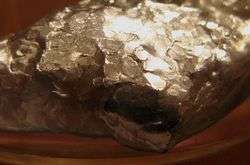Wood's metal

Wood's metal, also known as Lipowitz's alloy or by the commercial names Cerrobend, Bendalloy, Pewtalloy and MCP 158, is a eutectic, fusible alloy with a melting point of approximately 70 °C (158 °F). It is a eutectic alloy of 50% bismuth, 26.7% lead, 13.3% tin, and 10% cadmium by weight.[1] The alloy is named for Barnabas Wood.[2]
Applications
Wood's metal is useful as a low-melting solder, low-temperature casting metal, high-temperature coupling fluid in heat baths, and as a fire-melted valve element in fire sprinkler systems in buildings. Medical gas cylinders in the United Kingdom have a Wood's metal seal which melts in fire, allowing the gas to escape and reducing the risk of gas explosion.
Wood's metal is commonly used as a filler when bending thin-walled metal tubes. For this use the tubing is filled with molten Wood's metal. After this filler solidifies the tubing is bent. The filler prevents the tube collapsing. The Wood's metal is then removed by heating, often by immersion in boiling water.
Other uses include making custom-shaped apertures and blocks (for example, electron-beam cutouts and lung blocks) for medical radiation treatment, and making metal inlays in wood.
Wood's metal is also useful for repairing antiques. For example, a bent piece of sheet metal may be repaired by casting a Wood's metal die from an intact example. The low melting temperature of Wood's metal makes it unlikely this will harm the original. The damaged piece can then be clamped in the die and slowly tightened to form it back into shape.
Wood's metal has long been used by model railroad enthusiasts to add weight to locomotives, increasing traction and the number of cars that can be pulled.
Wood's metal is also used in the making of extracellular electrodes for the electro-physiological recording of neural activity.[3]
Like other fusible alloys, e.g. Rose's metal, Wood's metal can be used as a heat transfer medium in hot baths. Hot baths with Rose's and Wood's metals are not in routine use but are employed for temperatures above 220 °C (428°F).[4]
Wood's metal has modulus of elasticity 12.7 GPa and yield strength 26.2 MPa. [5]
Toxicity
Wood's metal is toxic because it contains lead and cadmium, and therefore contact with the bare skin is thought to be harmful, especially in the molten state. Vapour from cadmium-containing alloys is also known to pose a danger to humans. Cadmium poisoning carries the risk of cancer, anosmia (loss of sense of smell), and damage to the liver, kidneys, nerves, bones, and respiratory system. Field's metal is a non-toxic alternative.
The dust may form flammable mixtures with air.
Related alloys
Several other alloys with similar low melting points are listed here.
| Alloy | Melting point | Eutectic? | Bismuth | Lead | Tin | Indium | Cadmium | Thallium | Gallium | Antimony |
|---|---|---|---|---|---|---|---|---|---|---|
| Rose's metal | 98 °C (208 °F) | no | 50% | 25% | 25% | – | – | – | – | – |
| Cerrosafe | 74 °C (165 °F) | no | 42.5% | 37.7% | 11.3% | – | 8.5% | – | – | – |
| Wood's metal | 70 °C (158 °F) | yes | 50% | 26.7% | 13.3% | – | 10% | – | – | – |
| Field's metal | 62 °C (144 °F) | yes | 32.5% | – | 16.5% | 51% | – | – | – | – |
| Cerrolow 136 | 58 °C (136 °F) | yes | 49% | 18% | 12% | 21% | – | – | – | – |
| Cerrolow 117 | 47.2 °C (117 °F) | yes | 44.7% | 22.6% | 8.3% | 19.1% | 5.3% | – | – | – |
| Bi-Pb-Sn-Cd-In-Tl | 41.5 °C (107 °F) | yes | 40.3% | 22.2% | 10.7% | 17.7% | 8.1% | 1.1% | – | – |
| Galinstan | −19 °C (−2 °F) | yes | <1.5% | – | 9.5-10.5% | 21-22% | – | – | 68-69% | <1.5% |
References
- ↑ "Gardner's Chemical Synonyms and Trade Names". John Wiley & Sons.
- ↑ Jensen, William B. (2010). "The Origin of the Name "Onion's Fusible Alloy"" (Archived Reprint). Journal of Chemical Education. 87 (10): 1050–1051. doi:10.1021/ed100764f.
- ↑ Frank K, and Becker MC. Microelectrodes for recording and stimulation. In: Physical techniques in biological research, edited by Nastuk WL. New York: Academic Press, 1964, p. 23–84.
- ↑ https://books.google.com/books?id=m-hibT7AaK8C&pg=PA135&dq=rose's+metal&lr=&num=50&as_brr=3&cd=22#v=onepage&q=rose's%20metal&f=false
- ↑ Do-Gyoon, Kim (February 2006). "Evaluation of Filler Materials Used for Uniform Load Distribution at Boundaries During Structural Biomechanical Testing of Whole Vertebrae". Journal of Biomechanical Engineering. 128: 161. doi:10.1115/1.2133770. Retrieved 3 May 2018.
Bibliography
- Birchon's Dictionary of Metallurgy, London, 1965
- Experimental techniques in low-temperature physics, G. K. White, Oxford University Press, Third Edition
External links
| Wikimedia Commons has media related to Wood's metal. |
- Making your own low-melting point eutectic: Science Toys: A metal that melts in hot water
- Burdakin et al., "Melting points of gallium and of binary eutectics with gallium", Metrologia, 2008